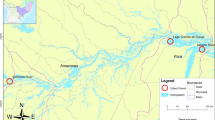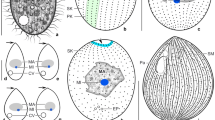Abstract
Ichthyophonus hoferi Plehn and Mulsow, 1911 is thought to be one of the few pathogenic fungal infections of marine fish. The result of an attack is severe epizootics in herring stocks with drastic reduction in the population as a consequence. The exact phylogenetic position of the genusIchthyophonus is not known. In the present study, a combination of molecular data, ultrastructure and biochemical characters were utilized to investigate the phylogeny ofI.hoferi. The genomic DNA encoding the small subunit ribosomal RNA (18S rRNA) was amplified and sequenced. Comparisons with other eukaryotic 18S rRNA sequences indicate thatI. hoferi is not a member of the Fungi. In both the parsimony and the neighborjoining trees,I. hoferi is the sister taxon to the rosette agent. The clade encompassingI.hoferi and the rosette organism is the sister group to the chanoflagellate clade in the neighbor-joining tree, while in the parsimony tree theI. hoferi/rosette clade is equally distant to both the choanoflagellate and animal clades. Transmission electron microscopy showed thatI. hoferi has a defined cell wall, an endoplasm that consists of a fine granulated matrix with numerous ribosomes, several nuclei, vacuoles of varying density distributed throughout the cell, and mitochondria with tubular cristae. The cell wall ofI. hoferi contains chitin.
Similar content being viewed by others
References
Alderman DJ (1982) Fungal diseases of aquatic animals. In: Roberts RJ (ed) Microbial diseases of fish. Academic Press, London, pp 189–242
Berbee ML, Taylor JW (1993) Dating the evolutionary radiations of the true fungi. Can J Bot 71: 1114–1127
Bhattacharya D, Elwood HJ, Goff LJ, Sogin ML (1990) Phylogeny ofGracilaria lemaneiformis (Rhodophyta) based on sequence analysis of its small subunit ribosomal RNA coding region. J Phycol 26: 181–186
Bowman BH, Taylor JW, Brownlee AG, Lee J, Lu S-D, White TJ (1992) Molecular evolution of the fungi: relationship of the Basidiomycetes, Ascomycetes and Chytridiomycetes. Molec Biol Evolut 9: 285–296
Bruns TD, Vilgalys R, Barns SM, Gonzalez D, Hibbett DS, Lane DJ, Simon L, Stickel S, Szaro TM, Weisburg WG, Sogin ML (1992) Evolutionary relationships within the fungi: analyses of the nuclear small subunit rRNA sequences. Molec Phylogenetics Evolut 1: 231–241
Caullery M, Mesnil F (1905) Recherches sur les haplosporidies. Archs Zool exp gén (Ser 4): 4: 101–180
Cavalier-Smith T (1987) The origin of fungi and pseudofungi. Symp Br Mycol Soc 13: 339–353
Cox P (1916) Investigation of a disease of the herring (Glupea harengus) in the Gulf of St Lawrence, 1914. Contr Can Biol Fish 1914–1915: 81–85
Daniel G (1933) Studies onIchthyophonus hoferi, a parasitic fungus of the herring (Clupea harengus). I. The parasite as it is found in the herring. Am J Hyg 17: 267–276
Del Sal G, Manfioletti G, Schneider C (1989) The CTAB-DNA precipitation method: a common mini-scale preparation of template DNA from phagemids, phages or plasmids suitable for sequencing. Bio Techniques 7: 514–519
Dorier A, Degrange C (1960) Levolution de l'Ichthyosporidium Ichthyophonus hoferi (Plehn et Mulsow) chez les salmonides d'élevage (truite are en ciel et saumon de fontaine). Trav Lab Hydrobiol Piscic Univ Grenoble 52: 7–44
Edman JC, Kovacs JA, Masur H, Santi DV, Elwood HJ, Sogin ML (1988) Ribosomal RNA sequence showsRneumocystis carinii to be a member of the fungi. Nature, Lond 334: 519–522
Elston RA, Harrel L, Wilkinson MT (1986) Isolation and in vitro characteristics of chinook salmon (Oncorhynchus tshawytscha) rosette agent. Aquaculture, Amsterdam 56: 1–21
Felsenstein J (1985) Confidence limits on phylogenies: an approach using the bootstrap. Evolution 39: 783–791
Felsenstein J (1995) PHYLIP (Phylogeny Inference Package) Version 3.57c. Distributed by the author. Department of Genetics, University of Washington, Seattle, Washington, USA
Förster H, Coffey MD, Elwood H, Sogin ML (1990) Sequence analysis of the small subunit ribosomal RNAs of three zoosporic fungi and implications for fungal evolution. Mycologia 82: 306–312
Gunderson JH, Elwood H, Ingold A, Kindle K, Sogin ML (1987) Phylogenetic relationships between chlorophytes, chrysophytes and oomycetes. Proc natn Acad Sci USA 84: 5823–5827
Gyllenstein UB, Erlich HA (1988) Generation of single-stranded DNA by the polymerase chain reaction and its application to direct sequencing of theHLA-DQA locus. Proc natn Acad Sci USA 85: 7652–7656
Harrel LW, Elston RA, Scott TM, Wilkinson MT (1986) A significant new systemic disease of net-pen reared chinook salmon (Oncorhynchus tshawytscha) brood stock. Aquaculture, Amsterdam 55: 249–262
Hepper CM (1977) A colorimetric method for estimating vesicular-arbuscular mycorrhizal infection in roots. Soil BiolBiochem 9: 15–18
Herzog M, Maroteaux L (1986) Dinoflagellate 17S rRNA sequence inferred from the gene sequence: evolutionary implications. Proc natn Acad Sci USA 83: 8644–8648
Hofer B (1893) Eine Salmonidenerkrankung. Allg FischZtg 18: 168–171
Huss VAR, Holweg C, Seidel B, Reidel V, Rahat M, Kessler E (1993) There is an ecological basis for host/symbiont specificity inChlorella/Hydra symbioses. Endocytobiosis Cell Res 10: 35–46
Johnson TW, Sparrow FK (1961) Fungi in oceans and estuaries. J Cramer, Weinheim
Kerk D, Gee A, Standish M, Wainright PO, Drum AS, Elston RA, Sogin ML (1995) The rosette agent of chinook salmon (Oncorhynchus tshawytscha) is closely related to choanoflagellates, as determined by the phylogenetic analyses of its small subunit RNA. Mar Biol 122: 187–192
Lauckner G (1984) Diseases caused by microorganisms. Agents: Fungi. In: Kinne O (ed) Diseases of marine animals. Vol. IV, Part 1. Biologische Anstalt Helgoland, Hamburg, pp 89–113
Maddison DR (1991) The discovery and importance of multiple islands of most parismonious trees. Syst Zool 40: 315–328
Mankin AS, Skryabin KG, Rubtsov PM (1986) Identification of ten additional nucleotides in the primary structure of yeast 18S rRNA. Gene (Amsterdam) 44: p 143
McVicar AH (1982)Ichthyophonus infections in fish. In: Roberts RJ (ed) Microbial diseases of fish. Academic Press, London, pp 243–269
Möller EM, Bahnweg G, Sandermann H, Geiger HH (1992) A simple and efficient protocol for isolation of high molecular weight DNA from filamentous fungi, fruit bodies, and infected plant tissues. Nucleic Acids Res 20: 6115–6116
Neish GA, Hughes GC (1980) Fungal diseases of fishes. In: Snieszko SF, Axelrod HR (eds) Diseases of fishes. Bk 6. TFH Publications, Neptune, New Jersey, pp 61–100
Okamoto N, Nakase K, Suzuki H, Nakai Y, Fujii K, Sano T (1985) Life history and morphology ofIchthyophonus hoferi in vitro. Gyobyo kenkyu 20: 273–285
Olmstead RG, Palmer JD (1994) Chloroplast DNA systematics: a review of methods and data analysis. Am J Bot 81: 1205–1224
Paperna I (1986)Ichthyophonus infection in grey mullets from southern Africa: histopathological and ultrastructural study. Dis aquat Org 1: 89–97
Patterson DJ, Sogin ML (1992) Eukaryote origins and protistan diversity. In: Hartman H, Matsuno K (eds) The origin and evolution of the cell. World Scientific, Singapore, pp 13–46
Pietra F (1990) A secret world: natural products of marine life. Birkhäuser Verlag, Basel
Pirozynski KA, Dalpé Y (1989) Geological history of the Glomaceae with particular reference to mycorrhizal symbiosis. Symbiosis 7: 1–36
Plehn M, Mulsow K (1911) Der Erreger der Taumelkrankheit der Salmoniden. Zentbl Bakt ParasiKde 58: 63–68
Rand TG (1990) Studies on the biology ofIchthyophonus hoferi Plehn and Mulsow, 1911 from Nova Scotian yellowtail flounder,Limanda ferruginea (Storer). Ph.D. thesis, University of New Brunswick, Canada
Rand T, Cone DK (1990) Effects ofIchthyophonus hoferi on conditions indices and blood chemistry of experimentally infected rainbow trout (Onchorhynchus mykiss). J Wildl Dis 26: 323–328
Saitou N, Nei M (1987) The neighbor-joining method: a new method for reconstructing phylogenetic trees. Molec Biol Evolut 4: 406–25
Simon L, Lalonde M, Bruns TD (1992) Specific amplification of 18S fungal ribosomal genes from vesicular-arbuscular endomycorrhizal fungi colonizing roots. Appl envirl Microbiol 58: 291–295
Sindermann CJ, Scattergood LW (1954) Diseases of fishes of the western North Atlantic. II.Ichthyosporidium disease of the sea herring (Clupea harengus). Fish Res Bull 19: 1–40
Sitja-Bobadilla A, Alvarez-Pellitero P (1990) First report ofIchthyophonus disease in wild and cultured sea bassDicentrarchus labrax from the Spanish Mediterranean area. Dis aquat Org 8: 145–150
Sogin M (1989) Evolution of eukaryotic microorganisms and their small subunit ribosomal RNAs. Am Zool 29: 487–489
Spanggaard B, Gram L, Okamoto N, Huss HH (1994) Growth of the fish pathogenic fungusIchthyophonus hoferi, measured by conductimetry and microscopy. J Fish Dis (Oxford, England) 17: 145–153
Spanggaard B, Huss HH, Bresciani J (1995) Morphology ofIchthyophonus hoferi assessed by light and scanning electron microscopy. J Fish Dis (Oxford, England) 18: 567–577
Sprague V (1965)Ichthyosporidium Caullery and Mesnil, 1905, the name of a genus of fungi or a genus of sporozoans? Syst Zool 14: 110–114
Sproston NG (1944)Ichthyophonus hoferi (Plehn and Mulsow, 1911), an internal fungoid parasite of the mackerel. J mar biol Ass UK 26: 2–98
Swofford DL (1993) PAUP: phylogenetic analysis using parsimony. Version 3.1.1. Computer program distributed by the Smithsonian Institution, Washington DC, USA
Wainright PO, Hinkle G, Sogin ML, Stickel SK (1993) Monophyletic origins of the metazoa: an evolutionary link with fungi. Seience, NY 260: 340–342
White TJ, Bruns T, Lee S, Taylor J (1990) Amplification and direct sequencing of fungal ribosomal RNA genes for phylogenetics. In: Innis MA, Gelfand DH, Sninsky JJ, White TJ (eds) PCR protocols: a guide to methods and applications. Academic Press, New York, pp 315–322
Author information
Authors and Affiliations
Additional information
Communicated by L. Hagerman, Helsingør
Rights and permissions
About this article
Cite this article
Spanggaard, B., Skouboe, P., Rossen, L. et al. Phylogenetic relationships of the intercellular fish pathogenIchthyophonus hoferi and fungi, choanoflagellates and the rosette agent. Mar. Biol. 126, 109–115 (1996). https://doi.org/10.1007/BF00571382
Received:
Accepted:
Issue Date:
DOI: https://doi.org/10.1007/BF00571382




